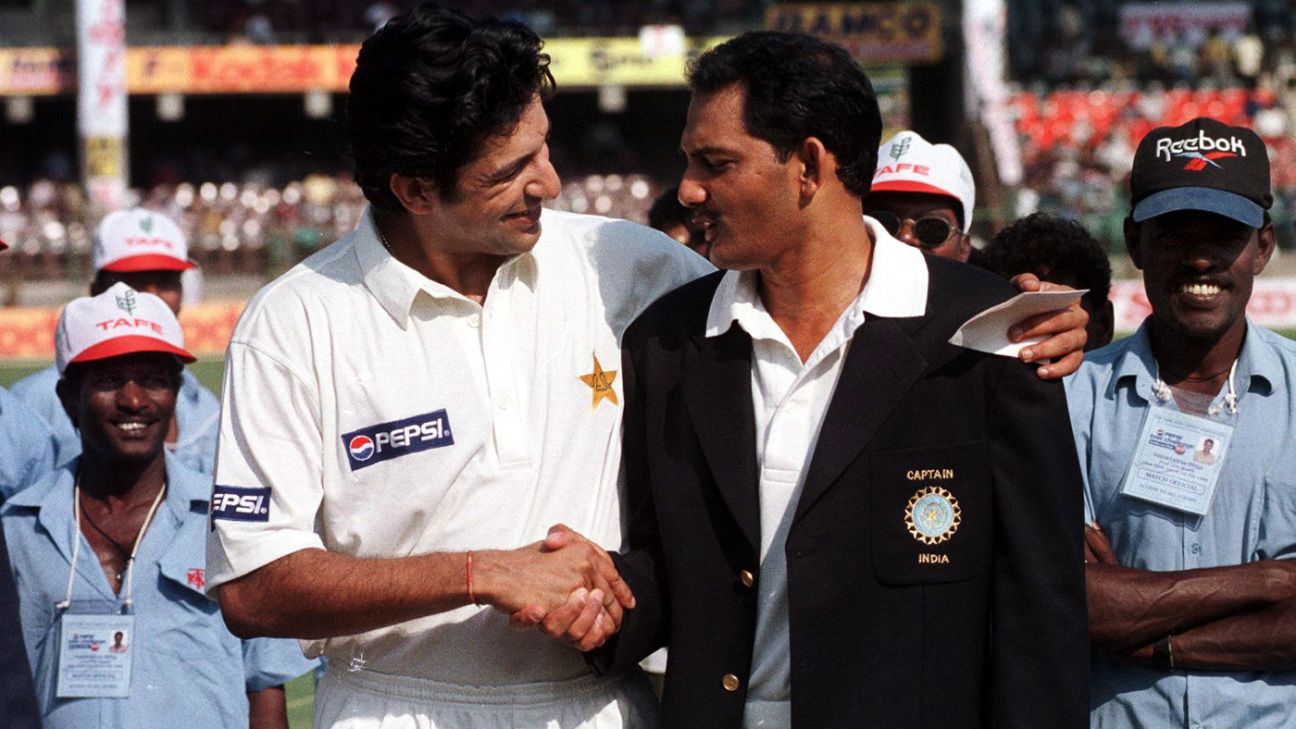When Sachin Tendulkar and Saeed Anwar opened against Murali and Vaas
During the 1996 World Cup, the writer Mike Marqusee traversed the subcontinent, taking in not just the cricket but the ways in which the sport was shaped by money, power, and national identities. The book he produced, War Minus the Shooting, is a rollicking retelling of a boisterous tournament as well as a shrewd, prophetic analysis of the evolution of cricket. Marqusee died in 2015, but he would have recognised so much of what colours cricket in 2021: the sport’s commercial crassness and the might of the Indian board, but also the crisp athleticism of the finest players. And he would have bemoaned how ugly nationalism has soured cricket between India and Pakistan, especially given his memory of one of the most splendid moments of the 1996 World Cup: a game of South Asian solidarity before the tournament began, in which India and Pakistan fielded a joint team against Sri Lanka.
Try Adsterra Earnings, it’s 100% Authentic to make money more and more.

2 Related
Outside the pavilion, I joined the little knot of local journalists covering the historic event. Eventually, Azhar and Wasim and the rest appeared, escorted by dancers and musicians in traditional costumes and a gaudily decorated elephant. The milling throng of heavily armed soldiers joined in the applause for the northern neighbours, as did most of the journalists. At the press conference inside the clubhouse, Azhar, Wasim and Intikhab Alam made all the right noises. ‘This proves to the world we’re all together. There’s nothing wrong as far as sport is concerned,’ Azhar mumbled earnestly. ‘This is history,’ a jubilant Intikhab insisted, ‘it’s the first time Indians and Pakistanis have played together on the same side. It’s a tremendous sight – everybody’s mixing like old friends. Let’s hope it’s a turning point in relations.’ Wasim agreed. ‘We are all very comfortable together. This is something for all our countries. I look forward to future joint teams, including Sri Lanka.’ Asked if he was worried about playing in the UK after the bomb blast there, the Pakistan captain laughed, ‘Ask other teams who are worried about bombs.’ When a reporter from the BBC tried to get their response to reports that explosives had been found near the ground, all three dismissed the question out of hand.
Neither Azhar nor Wasim was to look as relaxed again until long after the World Cup was over. In India, Azhar’s marital problems had been front-page news (he had left his wife and children in Hyderabad to move in with a Bombay-based television model named Sangeeta Bijlani), and his leadership was under attack from retired players. In Pakistan, Wasim was caught in the crossfire between PCB factions. Their respective home supporters expected nothing less of both captains than World Cup victory. For the moment, however, the two men could bask in the Sri Lankans’ gratitude. And their pleasure in playing together was genuine. After all, the Indian and Pakistani cricketers inhabit the same world, share many of the same experiences, not least the burden of national expectation placed on them every time they play each other. What a relief it must have been to be welcomed simply for turning up, and not to have to worry about winning or losing, especially on the eve of a tournament where winning and losing was to mean so much to so many.
Outside, the high commissioners of India and Pakistan joined Kadirgamar for the flag-raising ceremony. The Sri Lankan foreign minister was ready with his sound-bite: ‘The world will note that south Asia can get its act together.’ For all the pomp and ceremony and the heavy security, the atmosphere was relaxed. The cricketers were dressed in whites, a reversion to tradition foisted upon the organisers by the undesirability of having the visiting side take the field in their clashing World Cup uniforms – Pakistan in dark green and India in pale blue. A red ball was to be used. The black sightscreens, prepared for the day-night match against Australia, had to be painted white early in the morning. The stadium, built in 1986 on reclaimed marshland and apparently unusable after the rainy season, sports a spongy outfield and a green pitch, the like of which I was not to see again until my return to England three months later. How the West Indies would have relished it! The Wills XI won the toss and invited Sri Lanka to bat.
Despite the last-minute announcement of the match (held on a working day), and despite the non-competitive nature of the occasion, 10,000 spectators were on hand as play got underway. And what was salient from the first was that all the banners and speeches, all the politicians’ exhortations, were nothing compared to the warmth and passion of the crowd. They gave the visitors, and their own Sri Lankan heroes, an unofficial welcome far more stirring than anything the officials could cook up. Instead of scattering across the circle of empty seats, the spectators were packed together into the two tiers of the main large stand, which they had decorated with scores of home-made banners and placards: 3 Musketeers – Arjuna, Azhar, Akram’; ‘Thanks India-Pakistan – Join with Sri Lanka – Keep South Asian dignity’; ‘Neighbours in need are neighbours indeed’; ‘Wills World Cup belongs to Asia – India, Pakistan, Sri Lanka, UAE.’ The crowd were here not only to see something but to say something. As Wasim walked back to his mark to begin the first over, a man carrying a giant banner made of the flags of the three nations stitched together dashed up and down the boundary edge, and the crowd roared, ‘Sri Lanka zindabad! India zindabad! Pakistan zindabad!’ Briefly I imagined the chant becoming the slogan of the 1996 World Cup, carried by a million voices across the cricket grounds of Asia.
To expectant applause, the wicketkeeper Romesh Kaluwitharana took strike. It was his first appearance in Colombo since his scorching performances as a newly promoted opener in Australia. He clipped Wasim’s first ball off his legs through midwicket for four, and a baila band in the upper tier of the big stand struck up a joyful noise. Baila, Sri Lanka’s popular dance music, evolved from a Sinhala folk idiom under the influence of the Portuguese. For the rest of the day, the band kept us company, its brass ensemble tootling melodically over the light-hearted rhythms of drums and cymbals. At times the music recalled samba or calypso, and at its roughest and slurriest it sounded like township jazz.
The band paused briefly when Kalu, as he is called in Sri Lanka (the word means ‘black’ in Sinhalese), was caught at short extra cover for 6, resulting in the piquant scoreline, ‘Kaluwitharana caught Tendulkar bowled Wasim Akram.’ As bowler and fielder ran to embrace each other, it was hard to believe that not twenty-four hours earlier Indian and Pakistani troops were exchanging fire across the disputed Kashmir border. Not for the only time that day, I felt a lump in my throat. I’m usually fairly resistant to cricket sentimentality, but I had no defence against this spectacle of subcontinental amity.
Asanka Gurusinha and Ranatunga mounted the only extended partnership of the Sri Lankan innings. On his five-foot-eight-inch skeleton, Ranatunga’s ninety kilograms of flesh looked abundant indeed. He chipped and chivvied and accumulated his runs without strain. The unsmiling Gurusinha was nearly as hefty, but taller, and today his aggressive big hitting contrasted with Ranatunga’s lethargic nibbling. Dashing back and forth in front of the main stand with a huge Sri Lankan flag, Percy and Lionel egged on the crowd, which cheered anything and everything of merit on either side:
‘Aussie prime minister is Keating
Australians are cheating’
Spectators danced around the boundary, waving Pakistani and Indian flags, and periodically darted on to the field to embrace Wasim or Azhar, who reciprocated with smiles and laughter. Once Ranatunga and Gurusinha were out, Anil Kumble mesmerised the remaining Sri Lankan batsmen with his accuracy and unnerved them with his bounce, bowling his quota of eight overs for 12 runs and four wickets. The Sri Lankans finished with a score of 168.
At the lunch interval I left the stifling press box and bought a cold lager from the vendors behind the stands. Beer, such an integral component of the cricket culture in England, Australia and the West Indies, is barred from the cricket grounds of India and Pakistan, but ever-present in Sri Lanka, along with the music. While the baila band rested, local chart-toppers blared over the tannoy. The crowd, mostly middle-class Colombo youth in jeans (despite the heat) and baseball caps, looked happy and healthy. Poor kids with no shoes and scrawny legs threaded their way among these well-fed giants, hawking single cigarettes and sticks of gum. Beyond the entry gates, visible from the vendors’ patch, there were green glimpses of dense tropical foliage.
Climbing to the upper tier, I joined the merry throng clustered around the trumpets, trombones, drums and cymbals. The flags of the three nations fluttered everywhere. Vaas opened the bowling and Tendulkar drove his first ball for four through cover. With the brass riffing and blowing over the non-stop dance rhythms, Tendulkar set about cutting and driving anything a fraction under- or over-pitched. In no time, his score raced to 36 (thanks to seven clean, crunching fours). Ranatunga now handed the ball to Muralitharan. This would be the offspinner’s first bowl in front of a home crowd since being called for chucking in Australia. As he loped in, the members of the baila band rose to their feet and the massed brass blew a fanfare. Then came one of those dramatic moments that only sport can provide. Had it appeared in a novel or a film, it would have seemed hopelessly contrived. Murali flighted his first delivery, Tendulkar mistimed a drive and Dharmasena, reaching over his head at mid-on, took the catch.
The brass fanfare splintered into a million improvised, ecstatic notes, the percussion rose to a thunderous din and the crowd danced with glee. The man next to me grabbed and shook my hand. ‘Murali, you are not guilty – your were only convicted by a grandson of an ex-convict’; ‘A new word for the Aussies’ dictionary – Muraliphobia’; ‘London bombed – where will sissy Warne go shopping?’
Soon Murali had a sleepy-looking Aamer Sohail caught at deep extra cover. No bowler’s action in modern times has been subject to as much high-tech scrutiny as Murali’s, and all the evidence (from multi-angle super slow-mo video recordings to goniometric calibrations) has been in the bowler’s favour. Today, no one questioned his action. The umpires, Cyril Mitchley and Mahboob Shah, had been scheduled to preside over the cancelled game against Australia. For Sri Lankan fans, by not no-balling Murali they had effectively given him an all-clear for the World Cup. The next day’s Island headline summed up the events at Khettarama from a Sri Lankan perspective: ‘Solidarity match: Murali survives scrutiny as Sri Lanka lose.’ Thanks to contributions from Azhar, Ajay Jadeja and Rashid Latif, the visitors achieved an easy victory, with six overs and four wickets to spare.
The result may have been of no consequence, but this match was far from meaningless. What mattered was the fact that it had taken place, and the spectators celebrated that fact and articulated its significance. For once the cliché about cricket being a unifier of peoples and nations came alive. All of us who were present had witnessed a practical demonstration of the arbitrariness of the Indo-Pak border and the absurdity of Indo-Pak enmity. International cricket, it seemed, did not have to be war minus the shooting. After the match, the cricketers were whisked off to a tea party hosted by President Kumaratunga at Temple Trees, her official residence. On the sprawling lawns, cricketers, ministers and diplomats (including the Australian High Commissioner) mingled. ‘India and Pakistan have displayed tremendous solidarity with us,’ Kumaratunga said. ‘This is the first time these two countries have come together. and I am glad that it happened in Sri Lanka. Sri Lanka may have lost the game but cricket won the day.’ For the moment, at least, it seemed that regionalism had transcended nationalism.
A new edition of War Minus the Shooting, published by 81allout Publishing, is out on Amazon
More Story on Source:
*here*
When Sachin Tendulkar and Saeed Anwar opened against Murali and Vaas
Published By













